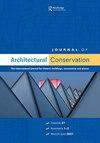A new morphological approach to Iranian bazaar: the application of urban spatial design theories to Shiraz and Kerman bazaars
IF 0.5
3区 艺术学
0 ARCHITECTURE
引用次数: 3
Abstract
ABSTRACT Situated at the center of cities, Iranian bazaars have not only shaped the structure of cities but also serve as a fundamental urban space. In recent decades, unsustainable developments deteriorating the old historic districts of cities have negatively influenced the physical, economic, and social aspects of bazaars. This is the most serious challenge of urban regeneration. Focusing on Shiraz and Kerman bazaars, the present research aims at proposing a new approach for studying the morphology of Iranian bazaars as highly distinguished urban sites. The qualitative method was applied to analyze these cases by conducting desk and field studies while investigating the historical maps of Shiraz and Kerman bazaars according to Trancik’s theories of urban spatial design (1986. Finding lost space: theories of urban design. John Wiley & Sons). Then, content analysis was used to extract the associated meaning of bazaar through in-depth interviews. The results show that Iranian bazaars, as an important urban space, have a pivotal organizational pattern according to figure-ground theory. Moreover, the so-called linkage theory suggested a group form and mega form role for Iranian bazaars which shapes the most important structure of the connections. Finally, the results of place theory indicated that these bazaars carry a symbolic value for nearby residents.伊朗集市的新形态研究:城市空间设计理论在设拉子和克尔曼集市中的应用
摘要伊朗集市位于城市的中心,它不仅塑造了城市的结构,而且是一个基本的城市空间。近几十年来,不可持续的发展恶化了城市的旧历史街区,对集市的物理、经济和社会方面产生了负面影响。这是城市更新面临的最严峻挑战。本研究以设拉子和克尔曼集市为重点,旨在为研究伊朗集市作为高度知名的城市遗址的形态提供一种新的方法。根据Trancik的城市空间设计理论(1986),在调查设拉子和克尔曼集市的历史地图时,采用了定性方法,通过案头和实地研究对这些案例进行了分析。寻找失落的空间:城市设计理论。John Wiley&Sons)。然后,运用内容分析法,通过深入访谈,提取出集市的关联意义。结果表明,根据图形地面理论,伊朗集市作为一个重要的城市空间,具有举足轻重的组织模式。此外,所谓的联系理论为伊朗集市提供了一种群体形式和巨大形式的作用,它形成了最重要的联系结构。最后,地方理论的结果表明,这些集市对附近的居民具有象征价值。
本文章由计算机程序翻译,如有差异,请以英文原文为准。
求助全文
约1分钟内获得全文
求助全文

 求助内容:
求助内容: 应助结果提醒方式:
应助结果提醒方式:


